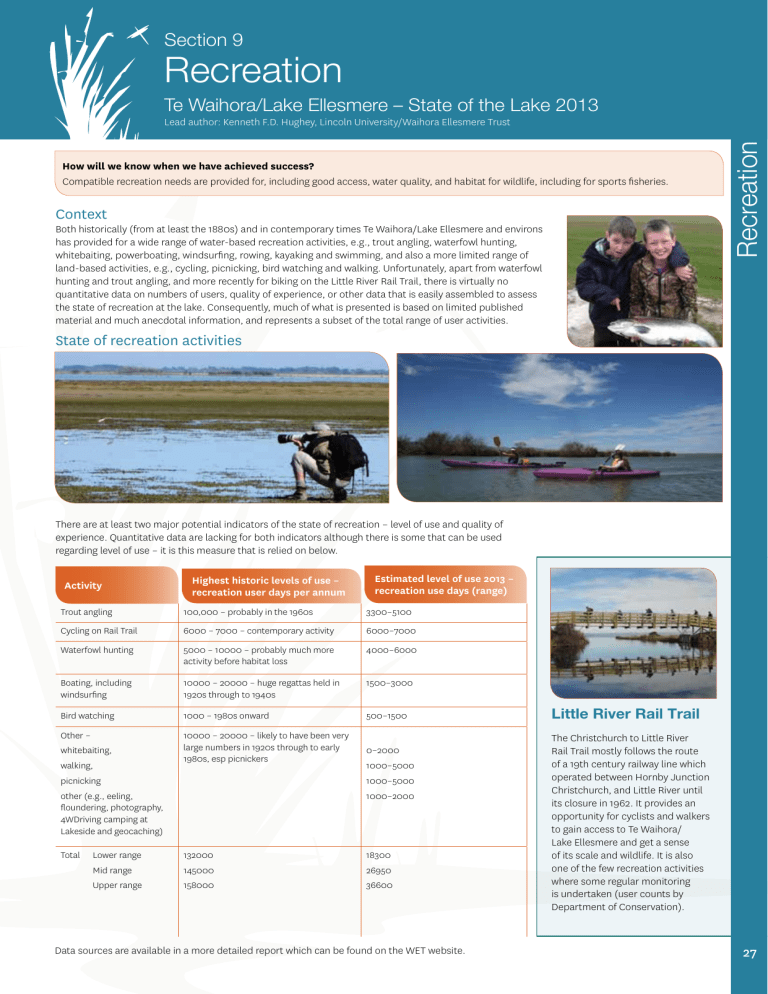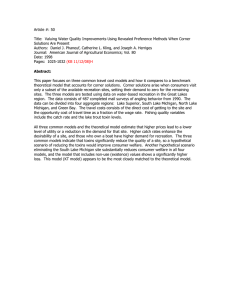Recreation Section 9 Te Waihora/Lake Ellesmere – State of the Lake 2013

Section 9
Recreation
Te Waihora/Lake Ellesmere – State of the Lake 2013
Lead author: Kenneth F.D. Hughey, Lincoln University/Waihora Ellesmere Trust
How will we know when we have achieved success?
Compatible recreation needs are provided for, including good access, water quality, and habitat for wildlife, including for sports fisheries.
Context
Both historically (from at least the 1880s) and in contemporary times Te Waihora/Lake Ellesmere and environs has provided for a wide range of water-based recreation activities, e.g., trout angling, waterfowl hunting, whitebaiting, powerboating, windsurfing, rowing, kayaking and swimming, and also a more limited range of land-based activities, e.g., cycling, picnicking, bird watching and walking. Unfortunately, apart from waterfowl hunting and trout angling, and more recently for biking on the Little River Rail Trail, there is virtually no quantitative data on numbers of users, quality of experience, or other data that is easily assembled to assess the state of recreation at the lake. Consequently, much of what is presented is based on limited published material and much anecdotal information, and represents a subset of the total range of user activities.
State of recreation activities
There are at least two major potential indicators of the state of recreation – level of use and quality of experience. Quantitative data are lacking for both indicators although there is some that can be used regarding level of use – it is this measure that is relied on below.
Activity
Trout angling
Cycling on Rail Trail
Waterfowl hunting
Boating, including windsurfing
Bird watching
Other – whitebaiting, walking, picnicking other (e.g., eeling, floundering, photography,
4WDriving camping at
Lakeside and geocaching)
Total Lower range
Mid range
Upper range
Highest historic levels of use –
recreation user days per annum
100,000 – probably in the 1960s
6000 – 7000 – contemporary activity
5000 – 10000 – probably much more activity before habitat loss
10000 – 20000 – huge regattas held in
1920s through to 1940s
1000 – 1980s onward
10000 – 20000 – likely to have been very large numbers in 1920s through to early
1980s, esp picnickers
Estimated level of use 2013 –
recreation use days (range)
3300–5100
6000–7000
4000–6000
1500–3000
500–1500
0–2000
1000–5000
1000–5000
1000–2000
132000
145000
158000
18300
26950
36600
Little River Rail Trail
The Christchurch to Little River
Rail Trail mostly follows the route of a 19th century railway line which operated between Hornby Junction
Christchurch, and Little River until its closure in 1962. It provides an opportunity for cyclists and walkers to gain access to Te Waihora/
Lake Ellesmere and get a sense of its scale and wildlife. It is also one of the few recreation activities where some regular monitoring is undertaken (user counts by
Department of Conservation).
Data sources are available in a more detailed report which can be found on the WET website.
27
Pressures (and driving forces) on recreation activities and management responses
Pressures affect quality of activity (and as noted there are few measures of this for state) which then impacts on user levels. Most pressures and responses are related therefore to quality parameters.
Activity
Pressures (and Driving Forces,
where identifiable)
Responses
Trout angling • Decline in fish numbers (bycatch, reduction in spawning trout numbers, and lack of good spawning habitat)
• Poor water quality (agricultural intensification)
• Managed access points – available for angling around the lake
• Advocacy programmes – Fish and
Game advocate for improved quality and quantity of water in the tributaries of the lake. If this is successful then the quality of the angling experience should improve, which in turn should be reflected in an increase in angler numbers
• Proposed Land and Water Regional
Plan (PLWRP) and Canterbury Water
Management Strategy (CWMS) efforts to improve water quantity and quality.
Cycling on
Rail Trail
Waterfowl hunting
• Access/facilities: Currently there is no offroad cycling connection between the trail and Christchurch (on-going planning issues).
Wind and lake flies can be annoying to cyclists
(Natural events, poor water quality)
• The trail is progressively being linked to others so that there is a continuous largely off-road connection to
Christchurch
• Conflicting values: Bird watching
(Government change to status of Canada goose meaning year round hunting allowed); restrictions on 4-wheel drive use (vehicle impacts on native vegetation).
• Lake level: Fluctuating lake levels affect waterfowl hunting (management regime)
• Water quality - Toxic algae warnings:
Perceived very seriously by duck hunters especially those using dogs
• Access points/visitor facilities: Duck hunters now have restricted access, for driving, to some parts of the lake (impact on native vegetation); Signage in poor condition
(resources) - causes confusion
• None, from a hunters’ perspective
• From other perspectives: plan rules restricting off road driving; DOC signage, management of maimais and the funding from the maimai fees is used for habitat restoration; lake opening protocol group that considers timing in relation to duck shooting season
• PLWRP and CWMS efforts to improve water quality
Boating, including windsurfing
Bird watching
• Water levels: Bad boating conditions occur when the lake is open to the sea for an extended period of time and the lake ‘bottoms out’ (management regime)
• Water quality: Algal blooms, occasional bad smell, poor water clarity (agricultural intensification)
• Access/facilities: Lack of launching sites for kayakers and rowers on rivers like the LII (Lack of recreational planning)
• PLWRP and CWMS efforts to improve water quality
• Conflicting values: Hunting scares birds and bird watchers (Government change of status for Canada goose means hunting year-round);
Off road driving
• Lake level: not being managed in a way that is appropriate for migratory wading birds
(management regime)
• Lake level management: Water
Conservation Order seeks to manage lake levels in a way that meets the needs of all native bird species, but also has to manage for fish and indigenous vegetation
Whitebaiting • Timing of lake opening: When lake openings do not occur at the right time there is effectively no whitebait run - it appears
October-November could be the best time for a lake opening (management regime)
• Management action: A spring lake opening provided for (WCO) and so lake likely to be open more often during the whitebait season
More information
This brief summary draws on a more detailed report, which is available from the WET website.
For background, context and information about other values associated with Te Waihora Ellesmere please see the other sections of the 2013
State of the Lake Report www.wet.org.nz/projects/2013-state-of-the-lake
Conclusions and recommendations
Te Waihora/Lake Ellesmere remains an important recreational resource in
Canterbury, and for bird watching is of international significance. However, most activities declined in use through to the
1970s/80s and have remained roughly static since – the main exception being the increase in cycling (because of the Rail Trail). Due to the fact there is little quantitative information about trends in numbers, quality of activity, and other related matters, it is important given proposed changes to management of the lake that the following are measured:
• User days per annum statistics for the main activities – trout angling, waterfowl hunting, whitebaiting, cycling, bird watching, walking and picnicking, i.e., user days per year – perhaps undertaken on a bi- or triennial basis;
• Quality of activity measures – size and number of trout, number of waterfowl, access and other visitor-related facilities and provisions including improved signage, ‘walk ways’, boat ramps including for kayaks on the L2, water level and quality parameters by activity: perceived quality can be gauged during the user days surveys;
Two other issues became apparent during development of this report:
1. There are conflicts between some recreation groups, e.g., Canada goose hunters and the needs of bird watchers and the birds themselves – a facilitated discussion forum is required to clarify and attempt to resolve these issues;
2. Along with the lack of indicator data there is a general lack of information about recreational opportunities and how best to manage them. An ongoing strategy to improve and share information could well be developed alongside the proposed case for constructing and developing a visitor/research centre.





